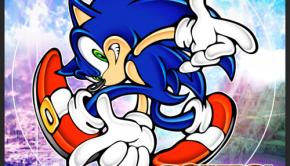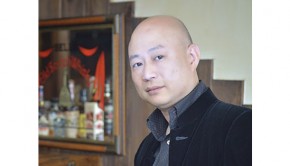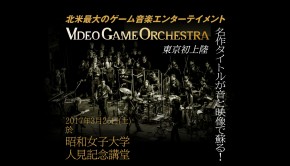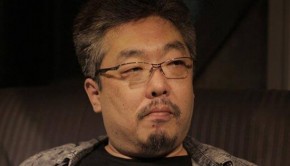Sonic Lost World Original Soundtrack -Without Boundaries-
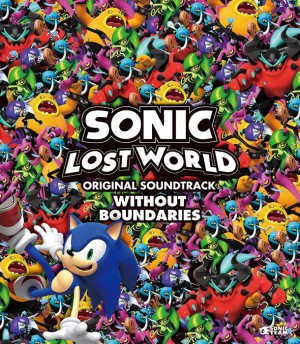 |
Album Title: Sonic Lost World Original Soundtrack -Without Boundaries- |
| Record Label: Wavemaster Entertainment |
|
| Catalog No.: WWCE-31296/8 |
|
| Release Date: November 27, 2013 |
|
| Purchase: Download via iTunes |
Overview
The Sonic the Hedgehog franchise has seen its fair share of criticism over the past decade. Sega and Sonic Team have admittedly struggled to find a proper direction for the series, oftentimes resorting to poorly received concepts and gimmicks that have marred the franchise. While games like Sonic Colors and Sonic Generations were generally well liked thanks to their clearer focus on Sonic’s traditional speed, subsequent releases again tried and failed to shake up the formula in meaningful ways. 2013’s Sonic Lost World, while in no way an awful game, was met with criticism and lower sales. However, time has led to a kinder retrospective on Lost World, mostly thanks to the disastrous pair of Sonic Boom games launched in 2014. At present, Sonic Lost World is looked upon as a flawed, yet enjoyable entry in the franchise, and features orchestral music composed and produced by Tomoya Ohtani, making this his fourth time leading on a main Sonic the Hedgehog title, along with composers Takahito Eguchi and Naofumi Hataya.
Body
I mention the lack of direction in the franchise, because, to a certain degree, this also translates to Sonic’s music. In the last few years of releases and remakes, Sonic has gone from 70s inspired hard rock (Sonic Adventure – Shadow the Hedgehog), to a dramatic and fast paced combination of rock and orchestra (2006’s Sonic the Hedgehog) to adventurous symphonies and world music (Sonic Unleashed and Sonic Colors). Right off the bat, Sonic Lost World’s main theme, “Wonder World,” changes its orchestral style to be less adventurous and much more whimsical. While the theme itself fits very well given the context of the game, and has a unique mix of orchestra, jazz piano chords, Latin-based percussion, and underlying synth notes, I can’t help but feel it’s somewhat underwhelming compared to the main themes of Sonic Unleashed and Sonic Colors, which were also composed by Ohtani. Comparatively, “Wonder World,” lacks a certain level of development and structure that previous main themes had, making it much less dynamic in retrospect. It also doesn’t help that the soundtrack underutilizes the theme, only regurgitating simplified versions of it for (11!) item and level clear jingles, and very rarely incorporates it in cutscene incidentals (“Cutscene – Opening,” for example) or other themes. One great rearrangement is “The Lost Hex,” the main map theme, but unfortunately this is truly the only arrangement that sticks out as actively arranging the theme. Although it’s a well-produced and fun orchestral theme, it simply isn’t up to par, and is severely underused.
Another primary motif comes in the form of “The Deadly Six Theme,” a fun, rollicking mixture of jazz and ska, which identifies the major villains in the game. Thankfully, unlike “Wonder World,” the theme get quite a few variations, including a full orchestra version, a version that places additional emphasis on the violin, and fast-paced “Boss Rushes,” versions that makes for compelling fight themes. Additionally, the theme gets re-incorporated several times in cutscene music, although usually in an overbearing “cartoon bad guys with pipe organs” kind of way. In any case, “The Deadly Six Theme” winds up being a highlight for the soundtrack, being able to switch from a fun boss fight theme, to something more imposing. Unfortunately, speaking of villain themes, Eggman’s identifying motif, one of the few reprising melodies throughout these games (first used in Sonic Unleashed) has been completely removed here, and is instead given a vague imposing motif, which oftentimes blends in with “The Deadly Six Theme.” Average listeners won’t notice its absence at first, and yet I found it somewhat jarring. The only time his new “theme” comes into play in any real substantial way is during the final boss theme, “Dr. Eggman Showdown,” a violin and electric guitar based rhythmic song, that isn’t as memorable as previous final boss melodies.
Thankfully, Ohtani and his team still know how to make infectious level music, complementing the gameplay aspects of Sonic Lost World wonderfully. “Windy Hill – Zone 1” and “Windy Hill – Zone 2,” are two of my favorite tracks, thanks to the fact that it sounds like Sonic should: fast-paced, fun, and creative. Utilizing violin, piano, and flutes, the tropical melody is analogous to previous level themes in the franchise, while still maintaining its own flavor throughout. More often than not, Ohtani takes a more jazzy approach to level themes, something he hasn’t fully explored in Sonic until now. “Honeycomb Highway,” “Silent Forest – Zone 1”, “Juice Archipelago,” and “Double Down,” all experiment with different types of jazz, from 60s funk, to Caribbean, and even straight up big-band numbers. These examples are very fun, and match the in-game components well, but every now and then the sound team abandons the jazzy elements to surprising results. For example, I would have never expected an Argentinean tango in a Sonic game, and yet the highly infectious and enjoyable “Midnight Owl” and “Owl Lights” are exactly that. “Dragon Dance,” combines the typical Sonic rhythm with Far East music, meshing fantastically with its flute/violin melody and piano chord backings. Lastly, “Sea Bottom Segue,” is perhaps one of the loveliest level themes to come from Sonic, having some beautifully done string and piano work, which adds a sense of speed, romanticism, and discovery to the soundtrack.
While the level and character theme music is the most prominent aspect of Sonic Lost World’s soundtrack, a lot of the pacing of the album is constantly hurt by the abundance of incidental cutscene music and power-up jingles, which roughly consists of 40 minutes of the soundtrack’s 2 hour and 35 minute runtime. These unfortunately add up to little more than filler, and are typically not interesting in the slightest. Only “Cutscene – Opening” uses a full orchestra, and almost everything else relies on distracting MIDI passages, or obnoxiously done electric guitars. Every once in a while, “The Deadly Six Theme” would be reprised, but the differences in instrumentation would immediately make itself apparent and ruin any sense of narrative the music would try to convey. Worse still, the “Wisp” power-up jingles, a returning element from Sonic Colors, amount to a collection of needless thumping beats and slight melodies, that loop just enough to become grating. Both the cutscene music and power up jingles are the most annoying part of Lost World, and really brought the whole experience down quite a bit whenever they came on.
Summary
Like its game, Sonic Lost World Original Soundtrack Without Boundaries is a fun but deeply flawed album. It lacks a clear focus and direction, and while it juggles around various tones and musical styles enjoyably, it becomes all too apparent that it really is aimless. The level music is well done, and its orchestral themes are produced gorgeously, but it doesn’t have anything to anchor these elements together. Instead it wastes 40 minutes on obnoxiously done cutscene music and jingles. This especially becomes notable if you proceed to buy the soundtrack off of iTunes or Amazon. Sega has had a terrible habit now of releasing its soundtracks in volumes, meaning that you have to purchase three “different” albums to get the complete soundtrack. It’s an awful practice, and makes this soundtrack surprisingly pricey, even as a digital download. Regardless, while it has some amazing tracks, I can really only recommend the full album to Sonic fans. It’s certainly not the best to come out of Sonic Team and Tomoya Ohtani, but can still be enjoyable for what it offers.
Do you agree with the review and score? Let us know in the comments below!
3.5
Posted on February 24, 2016 by Julius Acero. Last modified on February 24, 2016.

